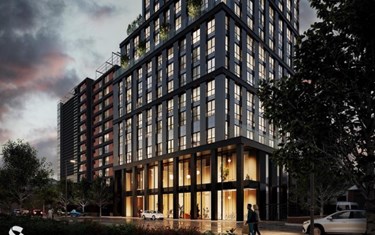
Jo Gregory MRTPI is the CPD Trainer for the Applied Urban Design Analysis online masterclass.
It was 2018 when I first heard about Carlos Moreno’s ‘15-minute city’-concept. I had been working as a planner for the best part of ten years and was completing my urban design masters. Such joy I felt when reading about this ‘concept’ that prioritised the ability of residents to access their everyday needs within a 15-minute walk. This is it, I thought, this draws everything that we know about good placemaking together into an easily comprehensible idea that can be implemented in existing settlements and help create new ones. Small changes and big changes can all work towards this goal.
This particularly struck a chord with me having grown up in a London suburb where although the public transport was frankly incredible compared to places I’ve lived since; the proximity of everyday services and facilities was not as convenient as you may imagine. I lived in-between two former villages subsumed by the conurbation, so trips to the GP, supermarket, hospital and school often involved a bus or tube trip or a lift from a parent.
It was therefore a revelation to move to the market town of Macclesfield. Macclesfield is a 15-minute settlement that already exists and functions well. The town has the structures in place that enable residents to walk or cycle to access everything. This encouraged me to focus my urban design dissertation on the enhancement of the town of Macclesfield using the 15-minute city principles.
The first stage was an in-depth analysis of how the town functions for pedestrians currently. I used recognised techniques such as Lynch’s legibility analysis, character and vernacular studies, analysis of hierarchy of streets and spaces and interviews with pedestrians. Together these built up a picture of the strengths and weaknesses of the town from the pedestrian viewpoint and identified features of the environment that were discouraging walking.
I have since felt sad and disturbed at the recent headlines regarding the 15-minute city and the interpretation that residents will somehow be confined and restricted by the concept. Rather than seeing this as a policy that results in more freedom and opportunity, the opposite is feared. The motivation behind some of these claims is varied, and fascinating to explore, but some of it links back to a fundamental misunderstanding of what constitutes good design.
Good urban design changes the lives of those who inhabit a place and can be very simple. However, we need to have the confidence to communicate these principles clearly as planners and to not over complicate the basics. We understand why the 15-minute city concept could be revolutionary, but can we articulate why that is the case and demonstrate how it can be implemented?
The first step communicating planning concepts to non-planners like politicians, stems from a sound understanding of place offered by urban design analysis. The use of recognised techniques to assess how people interact with the built environment is key. If we can understand how people move through place, we can ensure that new developments respond in a way that enhances connections and gives people more and better options outside of private car use. We can also adapt existing places to better serve those on foot and reduce the symptoms of car-centric design that is still sadly the norm.
All planners have an inherent interest in how places function and serve those who use them. Therefore, it is crucial for planners to have a good understanding of urban design principles and how they can be the key to realising successful places that add vitality and vibrancy to people’s quality of life.
Planners need confidence in their own perceptions and judgements and need to be skilled in the use of urban design analysis techniques that gives them the tools to articulate and evidence their judgement.
Join me for the next Online Masterclass where I will lead on this topic and help you develop your skills in urban design analysis techniques and improve your confidence for your next project proposal and presentation.
The Online Masterclass – Applied Urban Design Analysis is designed for
- Planners from all parts of the sector who determine applications of all scales
- Planners who work with applicants to prepare proposals.
Please search for the next upcoming date in the CPD Masterclass Calendar.
After you complete an online CPD masterclass your Certificate of Attendance is downloadable with 7 CPD hours credit that you can add to your professional development records for this year.
You will not miss any updates on RTPI Training if you sign up to the online monthly CPD Training Newsletter.


